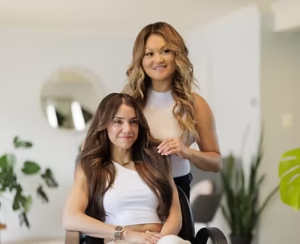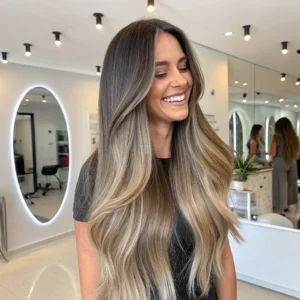How to Obtain Hair Extension Samples for Quality Evaluation: A Detailed Guide
To obtain hair extension samples1 for quality evaluation2, you can order them from various suppliers who offer sample programs, often for a small fee covering shipping. Some suppliers provide free samples with only a shipping charge. You can also find specialized hair testing services3 that analyze hair extension quality, including testing for synthetic materials4. This straightforward approach not only saves time but also ensures you receive a clear, genuine evaluation of what you're dealing with. If you're like me, navigating this tangled web (pun intended) of suppliers and options can feel overwhelming. But worry not, because I’m here to guide you through the process, pulling from both industry insights and my own personal experiences.
How to Test the Quality of Hair Extensions?
Evaluating the quality of hair extensions is akin to embarking on an investigative journey. It's a task of patience and precision, requiring both practiced expertise and instinctive understanding.
Dive Deeper: Nuances of Quality Assessment
When it comes to testing the quality of hair extensions, there are multifaceted elements to consider. Testing encompasses more than just assessing softness or durability; it involves a holistic analysis of various factors:
-
Texture and Softness:
- Natural hair has a unique texture, determined by its origin and history. Feel the hair in your hands; its softness and smoothness can often reveal its authenticity.
-
Consistency of Bundle Color:
- Quality hair extensions have consistent color throughout, which reflects uniform processing. An uneven color may indicate low-quality dye or pre-treatment.
-
Shedding and Tangle-Free:
- Gently brush the extension. High-quality extensions should not shed excessively and should be easy to manage without knots.
-
Durability Through Wash Tests:
- Real human hair will maintain its integrity even after multiple washes. This can be tested on a sample to observe how well it holds up over time.
-
Synthetic Presence:
- Use fire tests5 as a traditional method: Human hair, when burned, creates ash and emits a distinctive burnt hair odor. Synthetic hair melts and has a plastic-like smell.
Here’s a comparison table to better understand these parameters:
| Factor | High-Quality Hair | Low-Quality Hair |
|---|---|---|
| Texture | Soft, natural, consistent | Coarse, uneven, possibly waxy |
| Color | Uniform | Striped, uneven shades |
| Shedding | Minimal upon combing | Significant loss of strands |
| Tangle Resistance | High; runs smoothly | Low; knots easily |
| Fire Test | Turns to ash, genuine odor | Melts, plastic odor |
How Much Are Quality Hair Extensions?
Ah, the cost conundrum. Pricing for quality hair extensions can vary dramatically, and understanding this can save you from overspending or underselling.
Dive Deeper: Understanding Value vs. Price
The cost of hair extensions balances between ethical sourcing6, quality of hair, and the processing methods involved:
-
Virgin Human Hair vs. Processed Hair:
- Virgin hair, untouched by dyes or chemicals, is costly but worth the investment for its natural look and feel. In contrast, processed hair may be cheaper but lacks longevity.
-
Production Techniques:
- Hand-tied wefts, requiring skilled craftsmanship, may demand a premium price over machine-made equivalents due to their superior quality and comfort.
-
Length and Thickness:
- Generally, longer and thicker extensions cost more. However, it’s pivotal to ensure that the additional cost reflects quality rather than mere additional fiber density.
-
Brand Reputation:
- Brands renowned for quality, like Plucharm Hair, often command higher prices but ensure peace of mind in quality and ethical sourcing6.
Consider this pricing differentiation table:
| Type of Hair | Average Price Range |
|---|---|
| Virgin Human Hair | $100 - $300 |
| Processed Human Hair | $50 - $150 |
| Synthetic Hair | $20 - $80 |
Where Do Companies Get Hair for Extensions?
The origins of hair used in extensions can have profound implications for both quality and ethics.
Dive Deeper: Trace the Source to Ensure Quality and Ethics
Understanding where extension hair is sourced is essential, not only for quality but also for ethical considerations:
-
Regional Sourcing:
- India's temple hair, for instance, is known for its natural durability and texture, often donated willingly in religious ceremonies.
-
Ethical Considerations:
- Engage suppliers who prioritize fair compensation and ethical sourcing6 to ensure that the extensions support sustainable practices.
-
Quality Assurance:
- Countries like Cambodia and Vietnam are renowned for their rich, glossy hair extensions; collaborating with suppliers from these regions can be beneficial.
-
Supplier Transparency:
- Always check the transparency of your supplier's sourcing methods. Ideally, suppliers like Plucharm Hair will openly discuss sourcing.
Did you know that ethical sourcing6 is a growing demand among consumers? More people are turning towards brands that ensure ethical practices in sourcing hair extensions, placing value over mere cost.
How to Know a Good Hair Extension?
Knowing a quality hair extension from a mediocre one can feel like hunting for a needle in a haystack – but it doesn’t have to be.
Dive Deeper: Discerning Excellence in Hair Extensions
To identify quality hair extensions, employ a detailed checklist:
-
Visual and Tactile Examination:
- High-quality hair should appear vibrant and healthy, not dull or brittle. Run your fingers through it to check for a natural feel.
-
Brand Reputation:
- Trust in reputable brands such as Plucharm Hair, known for transparent practices and ethical sourcing6. They exemplify how business credibility mirrors product quality.
-
Customer Reviews and Feedback:
- Before committing, delve into reviews and testimonials. Genuine experiences from other users can provide invaluable insights.
-
Trial Runs:
- Before finalizing a bulk purchase, secure a few samples for trial runs7, which is a practice we at Plucharm Hair advocate fiercely.
By integrating these insights, you're well on your way to ensuring that the extensions align with your expectations and deliver exceptional results for your salon.
Conclusion
Navigating the multifaceted world of hair extensions is a journey in itself, yet with the right tools and knowledge, one can traverse it with ease. Obtaining samples for quality evaluation2 isn't merely about acquiring a product; it’s about aligning with suppliers that honor quality and trust. At Plucharm Hair, since our inception, we've dedicated ourselves to empowering partners with top-tier products, ensuring both quality and sustainability in the beauty industry.
Remember, distinguishing between high and low-quality extensions comes down to a sharp eye, a keen understanding of your supplier's integrity, and an unwavering commitment to excellence. Join me in this venture to uplift our industry standards, one extension at a time.
By following these insights, you’re better prepared to meet market demands, surmount challenges, and ultimately, enhance the authenticity and efficacy of your salon business. Dive into this world prepared and the results will reflect back in spades.
-
Explore this link to find reliable suppliers offering hair extension samples for quality evaluation. ↩
-
Learn effective methods for evaluating hair extension quality to ensure you make informed purchases. ↩ ↩
-
Discover services that analyze hair extension quality, ensuring you get the best products. ↩
-
This resource will help you understand how to differentiate between human and synthetic hair. ↩
-
Discover how fire tests can help you determine if hair is human or synthetic. ↩
-
Explore the growing demand for ethical sourcing practices in the hair extension market. ↩ ↩ ↩ ↩ ↩
-
Discover why trial runs are essential before making bulk purchases of hair extensions. ↩





